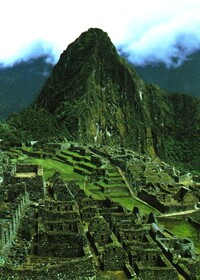Photo. Machu Picchu, Peru - high in the Andes of South America - is the ultimate Inca wonder: a city in the clouds, built with precision, mystery, and spiritual intent. © Travel Explorations.
I came up with theories - some logical, some wild. Maybe the Incas knew something we haven`t noticed or forgotten. I hoped to leave with something only I knew – a revelation not found in books or scientific reports, but uncovered in silence, caught in my gaze. But in the end, I had to admit there was a crack in every theory. A missing piece I couldn’t explain. And maybe that’s the point.
Some mysteries are not meant to be solved – they are meant to be felt. These places are not just ruins. They are messages. I just tried admiring the ancient wonders without overloading my brain with too many enigmas.
The famous Machu Picchu is not an isolated wonder, but part of a whole network of enigmatic Inca sites in and around Cusco in Peru. This city, known as the “City of the Puma”, is full of history and mystery. Located in the Peruvian Andes, Cusco retains much of its architectural and cultural splendour.
It all began in Cusco. Around 1100–1200 CE, according to Inca legends, Manco Cápac and Mama Ocllo emerged from Lake Titicaca and founded Cusco as the centre of the Inca world (empire).
Compared to many modern cities, I believe the way the Incas designed Cusco deserves to be at the top on UNESCO’s Cities of Design list. Its layout wasn’t just practical — it was symbolic, sacred, and deeply intentional. UNESCO’s Cities of Design highlight places where planning, beauty, and culture come together. Cities like Brasília, shaped like an airplane, express bold, modernist ideals. Paris stuns with symmetry and sweeping boulevards. Amsterdam is built for movement and balance, flowing with canals and clean lines. Kyoto follows an ancient grid, blending nature with spiritual calm. Florence, heart of the Renaissance, is crafted on a human scale - elegant and intentional. And then there is Cusco.
This city goes deeper. It wasn’t just built - it was aligned. Shaped like a puma, mapped to the stars, and grounded in myth, it reflects a worldview where city, sky, and spirit are one. From the hills above, the city still looks like a puma, the sacred animal of strength and protection. Every corner once followed a deeper order, as if the streets were drawn from the stars. The Incas believed the Earth mirrored the sky.
Some archaeological sites in Cusco are believed to form parts of the puma shape that defined the city’s sacred layout (must be viewed from a specific angle from above). The temple of Sacsayhuamán is said to represent the head, with its jagged walls echoing teeth or fur. The wo rivers outlined the body. The main plaza, Hawkaypata, was in the belly. The Qenqo (Kenko) ziggurats, carved with ceremonial channels and altars, are thought to represent the claws.
I started in Cusco. From there, my first stop was Ollantaytambo - a living Inca town surrounded by towering terraces and massive stonework. Some of the stones used in its Temple of the Sun were brought from a quarry on the opposite mountainside, across the Urubamba River, then hauled uphill. Starred at these enormous stones, wondering how they moved them that without breaking their back or budget?
The largest stones there weigh over 50 tons, with some sources indicating weights up to 50-70 tons, or even up to 80 tons for some granite blocks used in the constructions. All without use of wheels, draft animals, excavators, wheel loaders, massive truck or cable-pulling winches. The way these blocks were shaped and fitted - tight, seamless, puzzle-like - shows a level of engineering that still stirs debate. It feels like more than just muscles were involved.
Next came Sacsayhuamán, just above Cusco on a relatively open, elevated area. The fortress walls zigzag across the hillside in massive formations. Some stones weigh over 200 tons and fit together with mind-bending precision - no mortar, no gaps. The sheer size and accuracy leave you wondering: how did they move them? How did they lift them? Even today, there is no clear answers. Also here, I assume the work of hands have been guided by something more than just muscles.
Deeper into the mountains, I reached Machu Picchu. Hidden in the clouds, perched high between two sacred peaks, it feels like a dream made of stone – more than I ever could imagine. Every structure is aligned; every rock seems placed with purpose.
The Intihuatana stone caught my eye - a carved pillar said to “tie the sun to the Earth.” It once marked the time of solstices, linking light and shadow to the rhythm of the heaven – like an astronomic clock or calendar. Think about that, Machu Picchu was built by the Incas without use of mortar, metal tools, or the wheel. More than 200 buildings sit atop the mountain. This demonstrates the Incas’ deep knowledge of architecture, agriculture, engineering, and astronomy.
When the engineering seems beyond what we expect for the time, explanations often drift into the mythic or the extra‑terrestrial. It the same with amazing constructions as for example Moai Statues, Easter Island (Rapa Nui) – Nazca Lines, Peru - Ba’albek, Lebanon - Tiwanaku (Tiahuanaco), Bolivia - Stonehenge, England - Nan Madol (Pohnpei, Micronesia). Anyway, for the Incas, their construction wasn’t just engineering; it was ritual. And at that point I think their constructions have very much in common with the other mentioned wonders.
Machu Picchu obviously a part of a greater story - one of many mysterious places scattered around Cusco. When seen together, they don’t just form a map of empire - they trace something deeper. A sacred landscape. A living blueprint of the Inca’s cosmic vision. Mountains, stones, stars, and spirit, all woven together.
Some believe even older cultures before the Incas shaped this region to reflect their understanding of the universe. When I stood among these wonders, I was thinking: the past is not gone - it stills speak. I started looking for answers, but I leaved with wonder.
Stein Morten Lund, 28th September 2025
Additional information
Read more about Cusco and the shape of the puma: The Great Inka Road: Engineering an Empire.












